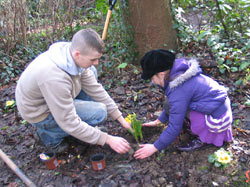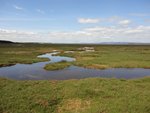
Saltmarsh is an amazing habitat….and I’m not just saying that because I’m a saltmarsh apprentice! It is a very dynamic ecosystem, that is ever changing, not least because it is faced with inundation by tidal water twice a day. This leads to a fantastic range of plants and invertebrates on the saltmarsh and adjacent mudflats, that have developed to live in this environment with its high levels of salt, and are highly specialised, often only found in these areas. Saltmarsh supports a wide range of breeding and wintering waterfowl and waders. As well as being highly important for its intrinsic conservation value, saltmarsh is performs an integral role in natural coastal defence, which if left untouched can be far more effective than man-made alternatives. It acts as a natural sea defence, acting as a buffer to adjacent land, by absorbing and weakening wave and tidal energy.
However, in recent times saltmarsh is rarely left alone to perform this role. Human activities have resulted in vast areas of saltmarsh being lost. The two main issues that threaten the extent of saltmarsh are reclamation for industry and agriculture, and ‘coastal squeeze’. Estuaries can often be important areas for the economy in terms of industry. This has seen saltmarsh and in some cases mudflats reclaimed from the tidal waters for development for industrial purposes. ‘Coastal squeeze’ is the term used to describe the effect often caused by the construction of man made sea defences such as sea walls. These man made structures exacerbate the erosion of the saltmarsh, which is often left in front of the walls, as it continues to act as a buffer for the wave and tidal energy but has no where to retreat inland, combined with the fact that the man made structures can often make the energies greater. This loss of saltmarsh which is happening in estuaries around the UK leads to a huge loss in biodiversity. This was recognised in the UK Biodiversity Action Plan of 1995 which required the creation or restoration of over 2,000 ha of saltmarsh by 2014.
Saltmarsh is not a habitat that is easy to restore once it is lost, environmentally, economically or politically. There are several techniques that can be used to try to recreate the habitat, these mainly focus on either encouraging sediment accretion and therefore the development of saltmarsh at sites within an estuary or managed realignment, where man made structures are breached and enclosed areas that were previously saltmarsh are allowed to once again be exposed to inundation by the tide twice a day and hopefully return to saltmarsh habitat with its related pool and creek systems, specialist vegetation and associated invertebrate and bird assemblage.
I am very lucky, one of the sites that I work on, the RSPB reserve at Nigg Bay in the Cromarty Firth, was the site of Scotland’s first such managed realignment scheme, which was undertaken in 2003. The field which was chosen for the realignment had previously been saltmarsh, this was shown by historical maps, and had only been enclosed for agriculture in the 1950s. Indeed the remnants of its creek system were still visible on aerial photographs. All of these factors combined meant that it was believed that this could be a viable site for coastal realignment. Two breaches were dug in the sea wall, and in March 2003 the tide once more inundated the site for the first time in fifty years.
Vegetation and invertebrate sampling were conducted both within the site and on reference mudflat and saltmarsh on the estuary side of the sea wall prior to the realignment. These surveys have been conducted several times in the intervening years allowing a real insight into the recovery and development of the saltmarsh at the site. I will be conducting the surveys this autumn to discover what the stage the saltmarsh development at the site is at in 2011. The site has done really well so far, with many of the pool and creek systems, a key feature of saltmarshes, reappearing in the past eight years. Many of the saltmarsh plants have colonised already, with the site currently awash with the purple flowers of Aster tripolium, sea aster. I also witnessed pairs of shelduck using the site on several occasions during my breeding bird surveys. The realignment site at Nigg is fantastic to observe and survey, especially as the tide comes in, but to stand still, nevermind replacing lost saltmarsh more recreation projects need to be undertaken….save our saltmarshes!
Other things that I have been doing include –
• Completing the breeding redshank and shelduck surveys. Initial analysis of the data shows the situation to be fairly positive for Shelduck with numerous breeding pairs on each of the reserves. The redshank, however, appear to be reflecting the national trend, with very few breeding pairs observed on the saltmarsh.
• A very interesting and informative meeting with the Dornoch Mud Rescue team, who gave me some great tips and advice for when I will be conducting my surveys on the mudflats. I even got to try out a pair of special overshoes, inspired by the feet of the great blue heron, to help with walking on mudflats.
• Conducting a litter pick at one of our reserves. It really highlighted the problems of marine litter and the issues that it can cause for the environment. A large percentage of the items were plastic bottles and we filled over 6 refuse sacks with litter.
• Control of invasive species on the saltmarsh, such as Spartina and Giant Hogweed, at two of the sites pesticides were used for control. However, as the Giant hogweed at one of the sites is both small in population and size at the moment, we were able to use a different method of control, cutting the tap root as they were easily accessible.
• I have also assisted with BTCV events, helping children and adults to get eye to eye with minibeasts.
Claire
Saltmarsh Apprentice


